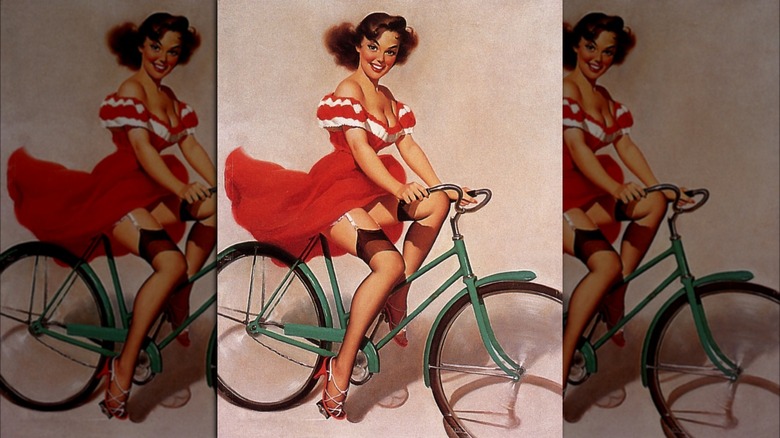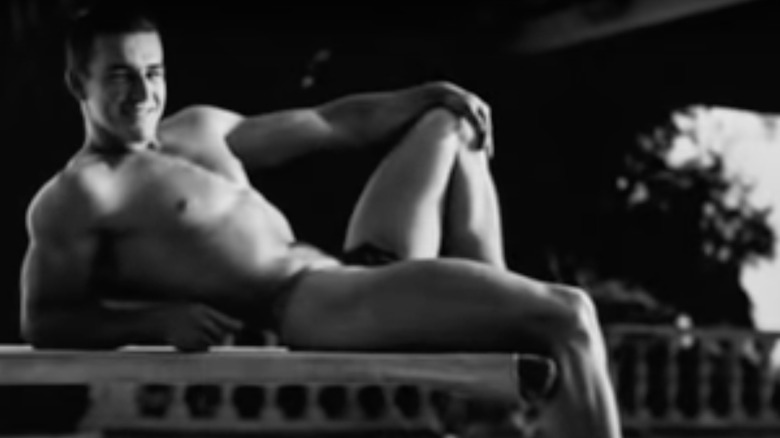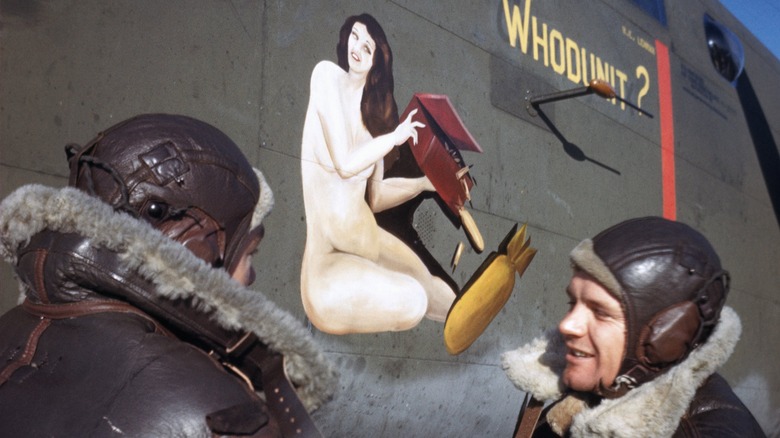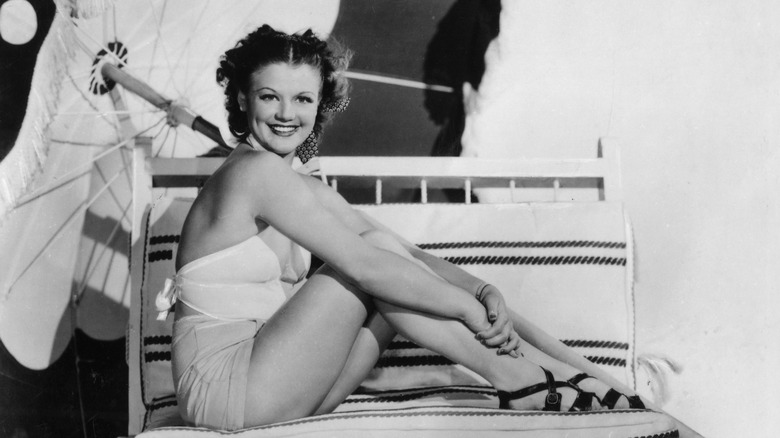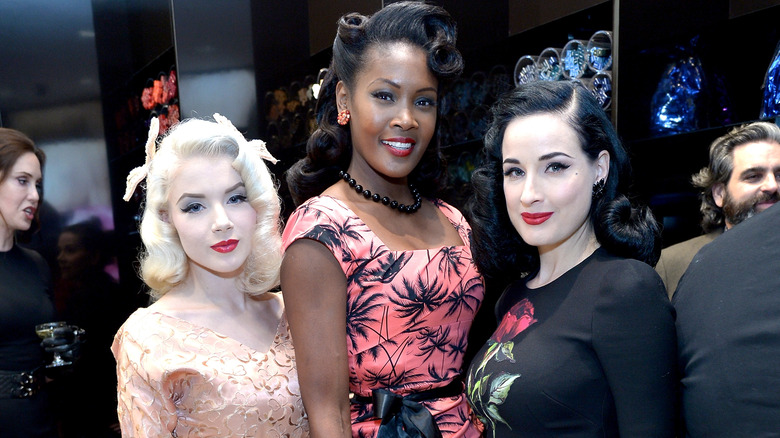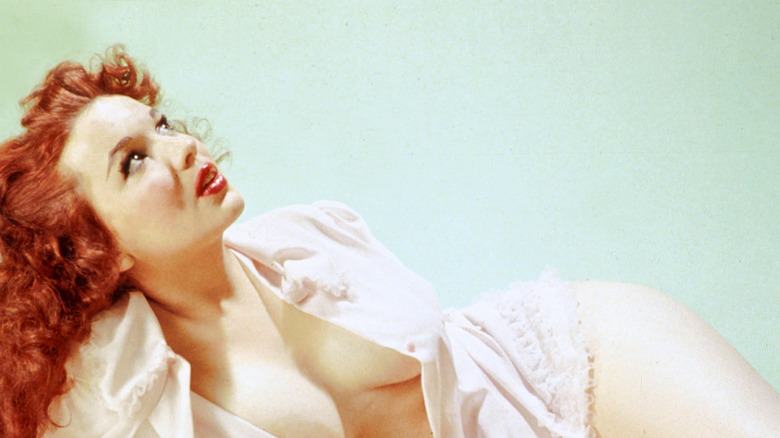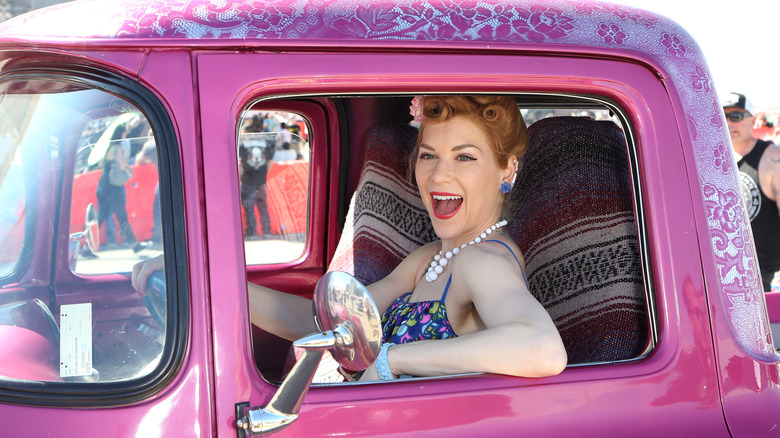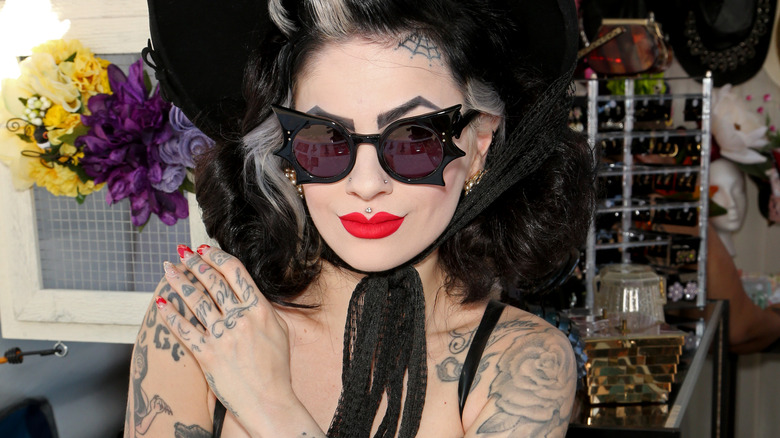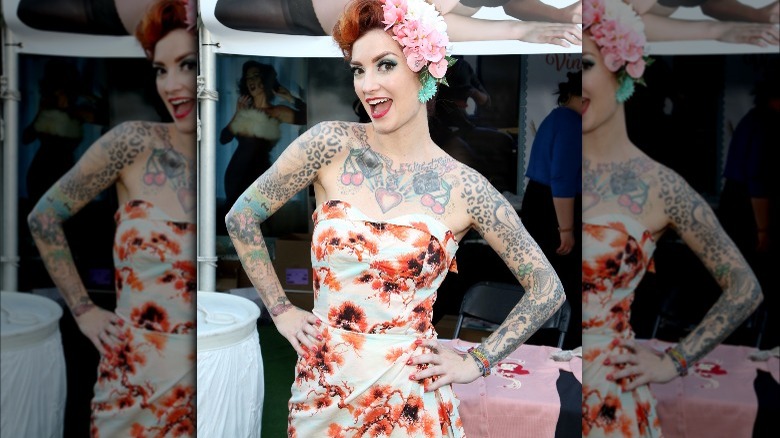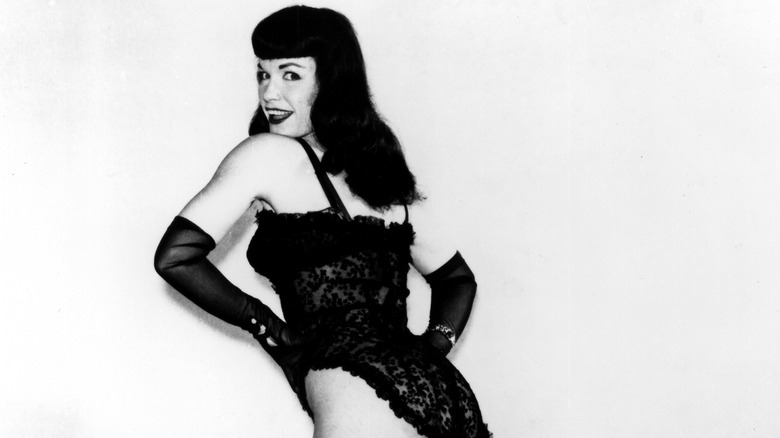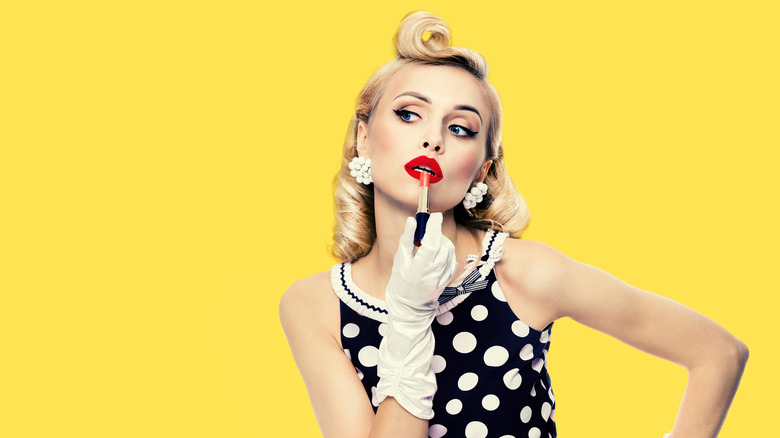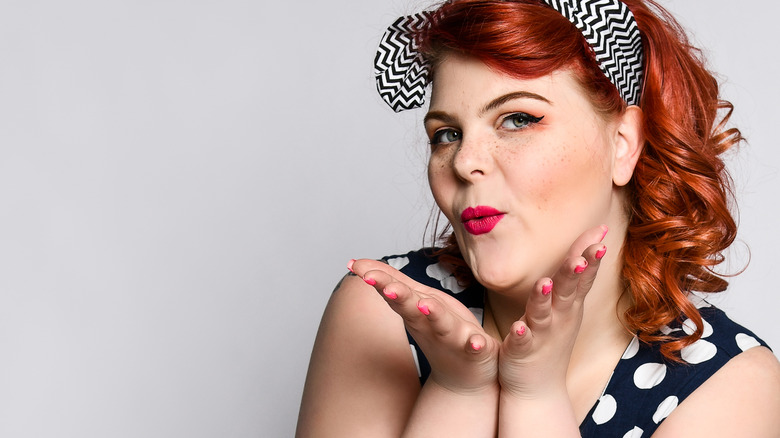The Untold Truth About Being A Pin-Up Model
Pin-up models, past and present, have faced a mixed reception — from accusations of objectification to enthusiastic admiration (via Brooklyn Brainery). Yet, the evolution of pin-up girls remains inextricably linked with women's journey towards greater independence and standing in society. After all, the pin-up girl contains a "subversive message" that helped push the envelope on women's rights beginning as early as the late 19th century. It all started with bicycles.
According to History Collection, when women started riding bikes at the turn of the century, society viewed it as scandalous activity. Some advertisements pushed the envelope by depicting women on bikes. Perceived as racy and suggestive (although tame by today's standards), these images helped usher in the pin-up girl genre. As a result, pin-up girls were controversial from the get-go.
As reported by All That's Interesting, CharlesDana Gibson, an illustrator for Life magazine, also had a significant impact on the pin-up genre. His so-called Gibson girl drawings depicted the ideal woman, full lips, hourglass figures, and all. Besides "shocking" bicycle girls and Gibson girls, French artist Henri de Toulouse-Lautrec also contributed to the future pin-up girl genre. His sensual (though well-clad) images of dancers at the Moulin-Rouge helped excite interest in voluptuous art, according to National Galleries. What did the women involved in modeling for these ads and artwork all have in common? They embodied the duality of "guilt and adoration" as argued by Geekade.
Pin-up models go by various names (and they aren't all girls!)
What's the origin of the term "pin-up?" Starting in the mid-19th century, burlesque performers participated in variety shows in which they performed on stage acting, dancing, and singing. These shows heated up over the decades, transforming into the first stripteases, although performers remained partially clothed throughout. To excite professional interest, these burlesque performers included scantily clad or even nude photos on their business cards.
In her book "Pin-Up Grrrls: Feminism, Sexuality, Popular Culture," Maria Elena Buszek explains how the performers "pinned" these cards in green rooms or tucked them in the frames of mirrors. Not only did this tradition give birth to the term "pin-up," but it provided many of the poses used in later images. These sexy pics also garnered another name: "cheesecake." According to Artnet Auctions, cheesecake was a publicly acceptable slang term for semi-nude and nude pictures of women in the early- to mid-20th century.
It started with a photo of a "Russian diva" named Elvira Amazar snapped by George Miller in 1915. "Why, this is better than cheesecake!" an editor in New York later said after seeing the photo (via Vintage Reveries). The rest was history. Of course, women aren't the only ones featured in sex-laden imagery. Male pin-ups also exist, first enjoying popularity in the 1940s and becoming known as beefcakes (via Beefcake Swimwear). Beefcakes have sold countless calendars, featuring everything from shirtless farmers to firefighters and even sexy priests (via "Mel Magazine").
Pin-ups know it's all about the tease
Whether scantily clad or nude, pin-ups excel at leaving something to the imagination. They also understand that just about any activity can appear sensual. According to Medium, images from daily life showcasing "overt coquettishness and pliable domesticity" often feature in pin-up art. Presumably, scenes of domesticity provided comfort to homesick soldiers who consumed these images during both World Wars.
During World War I, racy postcards of Miss Fernande circulated in the trenches (via We Heart Vintage). Born in the 1890s, Miss Fernande left few clues about her early life. But French photographer Jean Agélou snapped her semi-nude and nude photos in the 1910s and the 1920s. The American government also got in on the pin-up craze with the Division of Pictorial Publicity created in 1917. According to All That's Interesting, the division crafted propaganda to support the war effort, including sexy pictures and artwork for the troops. What did all of these images share? The art of the tease, which any pin-up girl worth her salt proves adept at.
History Collection reports that soldiers even received free pin-up images during World War II to keep up morale. And World War II saw the most prominent pin-up images painted on the noses of bombers. Playboy magazine launched in 1953 to great success, and founder Hugh Heffner modeled his publication on pin-up girl art. A veteran of World War II, Heffner understood the appeal of pin-up models and the tease.
Pin-ups uphold an exclusive standard of beauty
From their scarlet lips to their wasp waists, pin-up girls have long been purveyors of the American dream girl (via History by Day). For men in the trenches of World War I or bomber planes of World War II, pin-ups represented symbols of what they fought for. According to pin-up art expert Louis K. Meisel, in an interview with Collectors Weekly, "These were the girls that the boys who fought in World War II and the Korean War came back to marry." It's no coincidence that the most successful pin-up girls learned to walk the line between innocence, grace, and sensuality with ease.
But pin-up culture hasn't remained locked in a time capsule, and the study of this genre represents a "burgeoning field," according to the Journal of Popular Culture. Although men once devoured images of wholesome, innocent, and naïve women who incited lust without acknowledging it, today's crowd is attracted to a different vision of femininity. Today's pin-ups are resourceful, tough, and intelligent, like Gina Carano, Milla Jovovich, Kate Beckinsale, and Angelina Jolie, per Jezebel.
Although perhaps counterintuitive, many pin-up models report that modeling has helped them overcome body image struggles. Today's standards of beauty prove more inclusive, with women of every shape and size represented. The same goes for those boasting tattoos and piercings. Naomi Elster writes in Medium, "Older women and plus-size women are proudly displayed beside younger, skinnier versions of beauty, and seeing women so obviously feeling confident and happy in their photographs is incredibly heartening."
Pin-ups realize that diversity is beautiful
Pin-up girls come in all shapes, sizes, and colors, but it wasn't always that way. In the 1940s and 1950s, some racist photographers refused to work with black pin-up models, claiming they proved less photogenic (via That Pinup). Fortunately, now pin-up models of all races are represented in the vintage fashion world.
What kinds of lived experiences do black pin-up models report? Lady Eccentrick told That Pinup, "I found that the vintage world has shown less prejudice than any other society. I'm not sure if my debut came at the right time, when society is moving to a more acceptance space, or my ethnic diversity has just simply been embraced — but it has been nothing but love." What does she attribute her success to? Hard work, education in the field, and staying true to herself.
Asian models have faced challenges working in the vintage fashion sphere. Depending on where they live, getting vintage clothing can prove difficult, and they must fight against harmful stereotypes such as the notion that pin-up is for Caucasian women alone, as reported by Sophia Florence. Yet, success is still possible. According to Miss Lilly Laurent, "My experience being an Asian American pin-up girl has proven to be oddly and surprisingly rewarding. I never set out to be a pin-up girl. I was a geeky, shy, socially awkward kid with no siblings ... [But] thanks to this little thing called social media, I somehow became a pinup girl," per That Pinup.
Pin-ups know it's not all about men
Despite its military origins, pin-up art isn't for the male gaze alone (via Collectors Weekly). Women appreciate (and even emulate) pin-up girl fashion. In "Pin-Up Grrrls: Feminism, Sexuality, Popular Culture," Maria Elena Buszak argues that "from its birth, the pinup has served as an image that pointedly eliminates the explicit representation of a sexual act by eliminating the presence of men (and generally, other women) and strategically covering the genital area."
Pin-up images also represent a celebration of feminine beauty and allure, which many models see as primary to their obsession with this artform. Indeed, many of the primary connoisseurs of pin-up art today are women, per Jezebel. And, according to the Journal of Popular Culture, three of the most talented artists of the pin-up Golden Age were women: Joyce Ballantyne, Pearl Frush, and Zoe Mozert. They helped set an exclusive standard of beauty as pin-up artists. Joyce Ballantyne and Zoe Mozert even used themselves as models, arguing no man could know the female form like a woman.
These women proved trailblazers in a male-dominated arena. They actively shaped their masterpieces, and Louis K. Meisel argues the feminine gaze is easily recognized in their work. In an interview with Collectors Weekly, he explains, "I would say that the women portray very beautiful, idealized women, but the images are less erotic." Like these female artists, today's pin-up girls control their identities and how they get represented.
Being a pin-up girl isn't all glamorous
Many people have misconceptions about what it's like to be a pin-up model, but it's far less glamorous than most think. It comes with wardrobe mishaps, less-than-stellar photoshoot conditions, and more. Writing for Geekade, model Angela Fernot discusses enduring bitterly cold weather for one photoshoot where she wore little more than a bikini top, shorts, and stilettos.
Besides enduring freezing temperatures, Fernot has also dealt with plenty of reactions from those who find out she's a pin-up model. These include everything from admiration to disdain. She writes, "In my experience, there are two types of reactions ... They either love it or they hate it. It is ALWAYS a very strong reaction one way or another, with arguments they follow either side."
Another pin-up model, Micheline Pitt, spends time debunking the so-called glamor associated with working in the pin-up industry on her blog Pinup Girl Style. She argues, "We are all as guilty of giving you an idea of this glamorous lifestyle you may think we lead, but in reality it is far from it." For example, she explains that maintaining a day job is necessary for the vast majority of models. As a result, the vintage fashion lifestyle remains a constant work-life balance challenge.
Anyone can become a pin-up model but it's hard work
Anyone can pursue pin-up or alternative modeling, according to Pinup Girl Style. The same goes for those interested in being burlesque performers. But you'll need to invest serious time, dedication, and work into carving out a niche. What does it take to make it in this field? According to Minot Little, writing for Punkabilly Clothing, forging a successful career requires persistence and long-term dedication. It's not something that's going to happen overnight.
Pin-up models also know how to get the look, whether a signature pose, tattoo, beauty mark, or hair color. The best pin-up girls build a niche around what makes them unique. Pin-up girls also realize how important studying the history of the genre is. That way, they have a firm grasp of the best poses to use and the looks they wish to cultivate. Experienced models recommend finding a pin-up or alt model to emulate and then studying how she became successful. That way, young models can capitalize on the lessons already learned by their predecessors.
Alt and pin-up girl models must also prove adept at doing their own hair and makeup. And they need to build a stellar collection of beautiful vintage clothing by cultivating a love of "browsing the cuts of the dresses, the flowing fabrics, the adorable heels" (via Geekade). Pin-up gurus also urge potential models to cultivate a strong sense of self-worth and confidence, two qualities that the best models possess in droves.
Pin-up models dole out serious dough for their career
Pin-up models also invest significant cash into their careers, according to Micheline Pitt of Pinup Girl Style. In 2012, she created a list of pin-up model expenses. They include $125 or more for hair and makeup and $250 to $450 for an excellent professional photographer.
Those who know people in the biz might be able to get a discount on hair, makeup, or photography. But the best models know these are areas where they shouldn't skimp when establishing a modeling career. Pin-up and alt modeling come with a startup investment of between $375 and $575 at a bare minimum, according to Pitt. Between 2012 and 2021, inflation led to a cumulative price increase of 18.34%, according to In 2013 Dollars. With this accounted for, that's a startup price of between $445 and $680.
Shelling out money for vintage clothing also means this hobby requires serious budgeting. For this reason, some pin-up models even sew their own clothes. According to Miss Monmon, venturing into the DIY pin-up girl universe doesn't have to be complicated. Inveterate pin-up models have some serious sewing time under their belts, and they can gain access to a wide variety of patterns online to help them get their vintage fashion fix on.
Bettie Page and Dita Von Teese are exceptions to the rule
When you hear the term "pin-up girl," who comes to mind? Many people think of Bettie Page, the "Queen of the Pin-ups," and Dita Von Teese. These two iconic women proved wildly successful, but they also represent exceptions to the rule, per Pinup Girl Style. Dita Von Teese has done everything from burlesque to exotic dancing and adult movies. Nevertheless, for some, her biggest claim to fame was marrying Marilyn Manson.
As for Bettie Page? While she enjoys immortality as a pop culture icon, the real-life woman lived a less-than-idyllic life. She started modeling at age 27 and quit seven years later when, according to Factinate, "she felt that she was getting too old." After her modeling career ended, she suffered from mental illness and had several failed marriages. She vanished entirely from the spotlight, refusing to let photographers take her picture. She wanted the public to remember her at the height of her beauty. But remarkably, she made one final appearance at the 50th anniversary of Playboy in December 2003, entering with Anna Nicole Smith (via CNN).
Nevertheless, Page set a high standard to follow. She embraced everything that a pin-up girl could be. According to the Los Angeles Times, Hugh Heffner described Bettie Page's appeal as "a combination of wholesome innocence and fetish-oriented poses that is at once retro and very modern." And Page even has a planet named after her: 184784 Bettiepage (via NASA), a testimony to her stellar fame.
Pin-up modeling is a hobby for most
Pin-up models often work for pennies if not for free, according to Pinup Girl Style. They do it for the love of the art rather than a desire to become wealthy. Micheline Pitt sets the record straight when it comes to earnings as a pinup-model: "I do not model for a living, I do not, nor have I EVER made any real money to survive for a living to pay my bills as a model. I have NEVER been paid for a magazine cover or article. That is correct, you read that right, NEVER PAID, NO REAL MONEY."
Her message couldn't get more straightfoward. That said, she does go on to clarify that she has received modeling compensation. But this compensation doesn't begin to cover the costs associated with staying in tiptop shape to keep getting work. She estimates being a minimum of $1,000 in the hole for her modeling career. But she also has no regrets and loves the life she leads.
Many people go into debt for their hobbies. Hunters and fishers spend thousands on gear, and the same goes for classic car lovers and art collectors. But pin-up models go in realizing that their hobby isn't going to make them rich or famous. Angela Fernot echoes Pitt's sentiment, noting, "I love being a model. I love seeing a man pick up a metal sign or a calendar that has my picture on it, hold it up to compare it to me."
Pin-ups know perception matters
The best pin-up models understand that perception matters, and they pursue this field because they love it, per Pinup Girl Style. They have control over how they're seen and what image they ultimately wish to cultivate. Angela Fernot articulates it this way on Geekade: "Almost everyone wants to be noticed or recognized. This is one of the ways that I choose to do so. I choose to play a role that is sexy, revealing, and far more provocative than I am in real life."
The vintage fashion sphere also places a strong emphasis on differentiation and being one's self rather than trying to conform to a pre-set mold. Sure, the girls might pose in 1950s garb befitting a Valium-popping mom, but many have a tattoo sleeve or two to accompany it. According to Medium, "The lack of an age limit, encouragement of quirky individuality, and embracing of diverse body types have all been used to argue that pinup fashion is feminist."
But what about those individuals that decry objectification? Pin-up girls, by their very career choices, acknowledge the subject is far from a black-and-white issue. Instead, human sexuality is a nuanced topic based on lived experiences. In her book "Erotic Faculties," Joanna Frueh offers a simple solution to the controversy, arguing, "As long as I am an erotic subject, I am not averse to being an erotic object."
